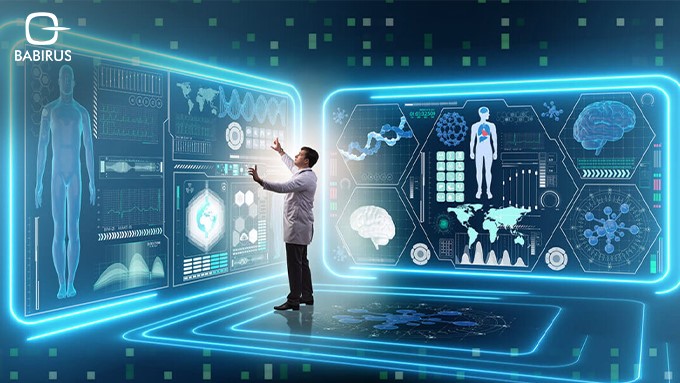Benefits of technology in improving patient outcomes and reducing healthcare costs

Can technology redefine the way we experience healthcare? From precise diagnostics to remote consultations from the comfort of your home, advancements in healthcare technology are turning what once seemed impossible into everyday practices. These innovations are enhancing care delivery, reducing expenses, and giving patients more control over their health than ever before.
Continue reading as we explore the benefits of technology in healthcare, focusing on how it improves patient outcomes, lowers costs, and drives innovations that are shaping the future of medical care.
How Technology Improves Patient Outcomes in Healthcare
Healthcare technology is changing how care is provided by offering more precise methods, quicker processes, and personalised approaches. These innovations contribute to better results by improving the accuracy, timeliness, and accessibility of treatments.
Advancing Diagnostics and Detection in Modern Medicine
Technology in healthcare has transformed diagnostic processes, making them more reliable and efficient. For instance, AI-powered tools analyse medical scans to detect diseases such as cancer or heart conditions at early stages. These advancements allow healthcare providers to take action sooner, leading to better results. Early interventions also help in reducing healthcare costs by preventing conditions from worsening.
Personalized Treatment Strategies for Better Health
One of the key contributions of healthcare technology is the ability to personalise treatments. Using patient data and genetic insights, doctors can create targeted care plans. This approach improves treatment success rates while reducing unnecessary tests or procedures. Personalisation ensures patient outcomes improvement by making care more precise and responsive to individual needs.
The Impact of Remote Monitoring and Telemedicine on Care
Devices that monitor health remotely and telemedicine platforms have made accessing healthcare more convenient and effective. Wearables connected through IoT track vital signs such as blood pressure and oxygen levels in real time. These tools also alert healthcare providers to irregularities, ensuring timely care. For chronic conditions, these tools enable consistent management, which is crucial for maintaining or improving outcomes.
Encouraging Patient Involvement in Health Decisions
Digital platforms, including apps and online portals, help patients take charge of their own health. Features such as appointment reminders, progress trackers, and educational resources encourage patients to remain consistent with their treatment plans. This engagement leads to better adherence and supports long-term improvements in patient health.
How Technology Can Significantly Reduce Healthcare Costs
In addition to enhancing care quality, healthcare technology offers significant financial benefits by minimising inefficiencies and focusing on prevention.
Enhancing Efficiency in Healthcare Processes
Administrative systems often slow down healthcare delivery and increase costs. Tools such as electronic health records (EHR) allow medical staff to access and share accurate patient information quickly. This reduces delays, avoids duplication of tests, and makes better use of resources. The benefits of technology in healthcare also include time savings for patients and staff.
The Importance of Prevention in Healthcare
Predictive analytics tools help identify patients who are at risk of developing chronic conditions, allowing for early action. For example, a patient identified as pre-diabetic can receive guidance to make lifestyle changes, avoiding the development of more severe conditions. These early interventions are vital for reducing healthcare costs while improving long-term outcomes.
Strategies for Minimizing Hospital Readmissions
Readmissions can be costly and stressful for patients. Remote monitoring devices and follow-up consultations through telemedicine reduce the chances of complications after discharge. By addressing potential issues early, these technologies prevent unnecessary trips back to the hospital.
Preventing Medication Errors for Safer Patient Care
Automation tools in pharmacies and electronic prescribing systems ensure medications are dispensed accurately. This reduces errors in dosages or drug combinations, preventing adverse effects. This improvement is an example of AI in healthcare cost reduction, as it saves resources while ensuring patient safety.
 Essential Technologies Transforming Healthcare Today
Essential Technologies Transforming Healthcare Today
Several technologies are transforming how healthcare is delivered, offering better care and financial savings:
The Role of Artificial Intelligence (AI) in Healthcare
AI supports healthcare in many ways, from analysing patient data to assisting in decision-making. AI tools identify patterns that help predict outcomes, allowing doctors to plan more effectively. By streamlining processes, AI in healthcare cost reduction is making a significant impact in both clinical and operational settings.
Telemedicine and Mobile Apps: Revolutionizing Patient Care
Telemedicine connects patients with healthcare providers through video calls and chat platforms, making care more accessible. Mobile apps complement these services by letting patients track their symptoms, monitor chronic conditions, and stay connected with their doctors. These solutions contribute to the telemedicine cost-effectiveness model, helping providers reach more patients without raising costs.
Wearable Technology and IoT Devices in Healthcare
Wearable devices, like fitness trackers and medical-grade smartwatches, continuously monitor health metrics such as heart rate and oxygen saturation. These devices send alerts to doctors when abnormalities are detected, enabling timely interventions. The role of IoT in healthcare is growing, making it easier to deliver care tailored to individual needs.
Utilizing Big Data and Predictive Analytics in Healthcare
Big data is being used to identify trends in patient care, predict risks, and allocate resources effectively. For instance, predictive analytics can forecast the likelihood of a disease outbreak or hospital readmission. These insights ensure that providers can act early, improving technology and patient outcomes while reducing inefficiencies.
The Importance of Electronic Health Records (EHR) in Care
EHR systems compile patient data in one place, enabling seamless communication between healthcare providers. This avoids repeated tests and ensures treatments are consistent, making EHR an important tool for reducing healthcare costs.
Overcoming Challenges in Adopting Healthcare Technology
While the benefits of technology in healthcare are transforming care delivery, adopting new tools presents several challenges. Overcoming these hurdles is key to ensuring positive changes in patient outcomes improvement and cost management.
Best Practices for Protecting Patient Information
The digitalisation of healthcare brings concerns about the safety of patient data. Medical records, diagnostic results, and other sensitive information are stored electronically, making them vulnerable to unauthorised access. A lack of strong security measures can disrupt operations and undermine trust. To safeguard information, healthcare providers must invest in robust security systems, conduct regular audits, and comply with legal data protection standards. Addressing these concerns is vital to supporting the use of technology in healthcare and maintaining patient trust.
Understanding the Costs of Implementing Healthcare Technology
The cost of implementing new technologies can be significant, especially for smaller healthcare facilities. Integrating tools such as AI diagnostic systems or wearable devices often requires additional infrastructure and custom software. These expenses can make adoption slower for organisations with limited budgets. However, the potential for long-term savings through improved efficiency and reduced errors makes this investment worthwhile. Providing financial support through grants or partnerships can help more facilities realise the benefits of technology in healthcare, particularly in achieving consistent care delivery and improved outcomes.
The Importance of Staff Training in Healthcare Technology
Adopting new technology requires healthcare professionals to learn new systems and processes. Training staff on tools like remote monitoring devices, electronic health records, and telemedicine platforms takes time and effort. Additionally, some staff may resist these changes, especially if they feel the tools are overly complex or disruptive to their workflow. Organisations can address these issues by offering clear, ongoing training, hands-on technical support, and opportunities for staff to provide feedback. Effective training directly supports patient outcomes improvement, as skilled staff are better equipped to use technology effectively.
Addressing Unequal Access to Healthcare Technology
While technology in healthcare has made significant advancements in improving accessibility, not everyone benefits equally. Rural areas often lack the infrastructure needed for telemedicine or wearable health devices, while low-income communities may struggle to afford these tools. Addressing these challenges involves offering affordable alternatives and improving digital infrastructure in underserved areas. Bridging this gap is essential for ensuring equitable healthcare delivery and unlocking the full potential of the telemedicine cost-effectiveness model.
Lastly,
The growing role of technology in healthcare is not just about innovation; it is about reshaping lives. Imagine a world where personalised treatments are the norm, remote consultations make healthcare more accessible, and costly errors are eliminated. With tools like AI, telemedicine, and wearable devices, this vision is already becoming a reality.
The journey comes with its challenges, but with dedication and collaboration, the rewards far exceed the obstacles. The future of healthcare will be smarter, more inclusive, and focused on what truly matters: better outcomes for everyone. Whether it is saving time, reducing costs, or empowering patients, technology is leading the way toward a healthier and brighter future.
